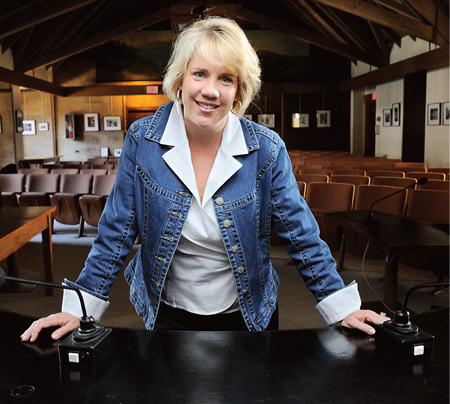Think Reese Witherspoon chatting about her breakout role in the hit movie Legally Blonde. That’s Shawn Marshall discussing Mill Valley politics. “I just love it,” she says, “It’s really community politics; it’s imperfect, sometimes difficult, but it’s almost always done in a neighborly spirit where people care about one another and seek to obtain consensus.”
Like Witherspoon’s character in Legally Blonde, Marshall is a blend of lively enthusiasm and focused business acumen. She is a third-generation Marinite, a twin born at Marin General and a mother to twin 7-year-old boys. She went to Marin Catholic High School, graduated from UC Davis, and then held staff positions at the Department of Housing and Urban Development in Washington, D.C., and the Federal Reserve Bank of San Francisco. After returning to her Marin roots, she was launched into politics through Leadership Mill Valley, a Chamber of Commerce seminar that dealt with the workings of city and county governance. “It really intrigued me; I was totally hooked,” she admits.
After chairing the creation of the scholarship fund at the Mill Valley Community Center, Marshall served on the city’s Parks and Recreation Commission, then was elected to the city council in 2005. “In early 2008, I was named mayor by a new council just after the lid blew off over the Miller Avenue Precise Plan,” she continues. “There was backlash, backstabbing and some really nasty behavior; we had to back off without losing the vision. We also had to bring peace to the city—and I think we’ve done both.”
Currently, along with serving on the Mill Valley City Council (she’ll run for reelection in November), Marshall is president of the League of California Cities North Bay Division (four counties, 31 cities), a legislative committee member of the Marin County Council of Mayors and Councilmembers and vice chair of the newly formed Marin Energy Authority.
Let’s imagine you have omnipotent powers: In 10 years, what three objectives would you like to see having been accomplished in Marin County?
Objective #1: With Marin Energy Authority’s guidance, I’d like to see the county leading the state—and possibly the nation—in weaning ourselves from an addiction to oil and fossil fuels. From a practical perspective that means we’ll have sustainable growth and land use policies in place, as well as transportation networks that are both convenient and cost-effective.
Objective #2: I would like to see a county that is more diverse, both ethnically and economically. When I grew up here, Mill Valley was full of artists, plumbers; there was an affordable kids shoe store and a person who made a living selling candles at Old Brown’s store. For the most part these folks aren’t able to live here anymore. I think that is tragic. From a public policy perspective, we owe it to ourselves to work hard on economic and ethnic diversity. And you start by providing housing choices that allow people of low income—even middle income—to live here. I think it is sad we’ve become a wealthy enclave. I believe there’s a role here for government to play.
Objective #3: I would like to see a robust transportation system in our county that does not urbanize our county. Basically, one that makes public transportation the more convenient and timely choice because in the end, I believe, that’s the only thing that will ever get people out of their cars. I love the idea of Larkspur Landing as Marin’s transportation hub; we’re already halfway there, and if we could somehow deal with the San Quentin issue and buy some of that land, I think that would be phenomenal. The SMART train is a step in the right direction; ultimately, I would like to see more stops along that line and know that will be controversial. From there, the answer will be better bus routes—if SMART is the spine, shuttles and buses will be the spokes. That will include movement around the county for shoppers, seniors, and school kids.
Anything else? Yes, in 10 years I would really love to see that Marin has continued its dedication to open space and our agricultural past. I think what we’re doing with Marin Organic and supporting our farmers in West Marin is wonderful. In doing so, in order to keep our 85 percent beautiful park-like open space that people love—which is why we pay the big bucks to live here—it’s important to understand the value of Marin’s city-centered corridor approach to sustainable development along Highway 101. That’s a reality check people don’t want to hear about today. Yet, in order to have a sustainable lifestyle Marin has to have diverse housing stock and a viable transportation network. We have to have an infrastructure that will make all of Marin County work for those living here now and future generations to come.


